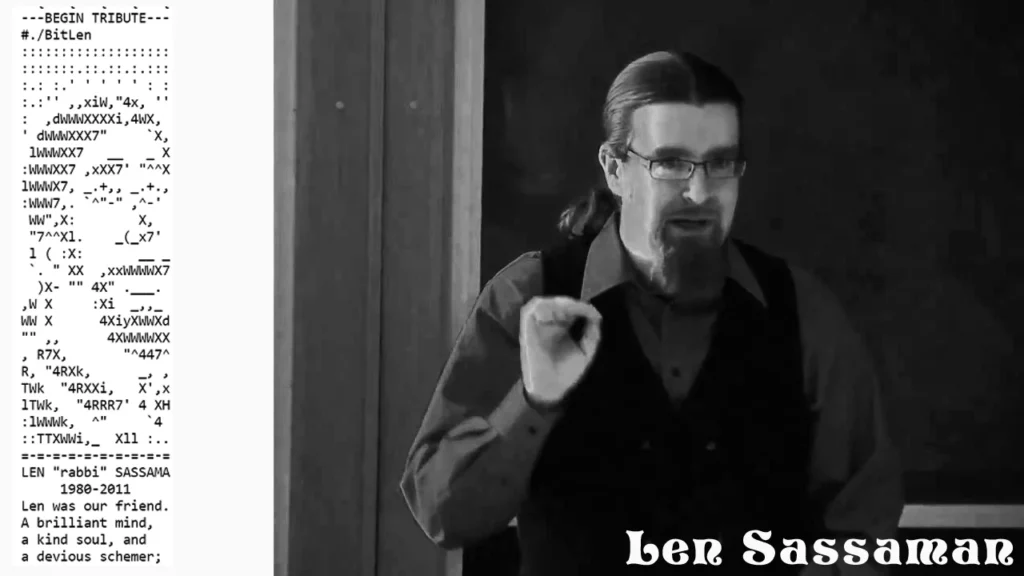The true identity of Satoshi Nakamoto, the mysterious creator of Bitcoin, has long captivated both the crypto community and the broader world. Over the years, several candidates have been proposed, from cryptographer Hal Finney to legal scholar Nick Szabo, but none have been definitively proven to be Satoshi. Recently, however, a new candidate has garnered attention: Len Sassaman, an American cypherpunk, cryptographer, and privacy advocate. With an upcoming HBO documentary, Money Electric: The Bitcoin Mystery, directed by Cullen Hoback, speculation about Sassaman’s connection to Bitcoin’s creation has grown. So, who was Len Sassaman, and could he really be the elusive Satoshi Nakamoto?
Early Life and Upbringing
Born on March 13, 1980, in Pennsylvania, Leonard Harris “Len” Sassaman exhibited exceptional intelligence and a passion for technology at a young age. As a child, Sassaman was deeply fascinated by computers and cryptography, an interest that would shape the trajectory of his life. Sassaman’s early years were marked by a profound curiosity about the intersection of privacy, technology, and freedom. He was deeply influenced by the cypherpunk movement, a group of technologists and privacy advocates who sought to use cryptographic technology to protect individual privacy and fight for digital freedom.
Raised in a family that encouraged learning and intellectual curiosity, Sassaman quickly became involved with the cypherpunk community, where he would go on to make significant contributions to the field of cryptography. As a teenager, he was already working on early encryption projects and was deeply immersed in the cryptographic technologies that laid the groundwork for later innovations like Bitcoin.
Sassaman’s Contributions to Cryptography and Privacy
Sassaman’s early professional career saw him heavily involved with Pretty Good Privacy (PGP), an encryption program designed to secure communications. His involvement in PGP and later GNU Privacy Guard (GPG), a free software alternative to PGP, made him a key figure in the cypherpunk community. These tools allowed individuals to encrypt their communications, enhancing their privacy and security in a world where governments and corporations were increasingly gaining the ability to spy on personal data.
Beyond his work with PGP, Sassaman is best known for his contributions to anonymous remailer technology. He helped build Mixmaster, a remailer system that allowed users to send anonymous emails by passing messages through a series of servers. This remailer technology was one of the most advanced systems for ensuring online privacy at the time and bore similarities to the pseudonymous nature of Bitcoin transactions.
Sassaman’s work aligned closely with the ideals of the cypherpunk movement: promoting privacy, decentralization, and freedom from government surveillance. His dedication to these principles was evident throughout his career, and many of the technologies he worked on contributed directly to the creation of decentralized networks and systems.
Len Sassaman’s Personal Struggles and Tragic Death
While Len Sassaman’s professional achievements were remarkable, his personal life was marred by ongoing struggles with mental health. He had been diagnosed with clinical depression from a young age and battled with his mental health throughout his life. Despite his personal struggles, Sassaman maintained a reputation for kindness, generosity, and brilliance within the cryptographic community.
On July 3, 2011, at the age of 31, Len Sassaman tragically took his own life. His passing came as a shock to the cryptography world, and tributes poured in from the many colleagues and friends he had worked with over the years. Sassaman was remembered as not only a brilliant cryptographer but also a deeply compassionate individual who believed in the importance of privacy and freedom in the digital age.
A significant tribute to Sassaman was encoded into Block 138725 of the Bitcoin blockchain, immortalizing his memory within the very technology he may have helped create. The message, reading “a friend, a kind soul and a devious schemer,” served as a heartfelt homage from his peers.

The Connection Between Len Sassaman and Satoshi Nakamoto
What has led many to suspect that Len Sassaman could be the real Satoshi Nakamoto? Several clues and coincidences have pointed to Sassaman as a potential candidate for Bitcoin’s creator:
- Timing of Sassaman’s Death and Satoshi’s Disappearance: On April 23, 2011, Satoshi Nakamoto sent his last known email to the Bitcoin community, announcing that he had “moved on to other things.” Just a few months later, Sassaman passed away. The proximity of these events has fueled speculation that Sassaman could have been Satoshi and that his death may explain Nakamoto’s sudden disappearance.
- Professional Connections: Sassaman was closely connected to Hal Finney, one of the earliest Bitcoin developers and another frequently speculated candidate for Satoshi. Finney received the first Bitcoin transaction from Nakamoto, and both he and Sassaman were deeply involved in the cypherpunk movement. Their professional collaboration and mutual interest in cryptographic systems have led many to believe that Sassaman had the technical knowledge and skills to create Bitcoin.
- Remailer Technology: Sassaman’s work on anonymous remailers and pseudonymous communication systems strongly aligns with the ethos of Bitcoin—a decentralized and pseudonymous currency. Sassaman’s contributions to Mixmaster and other privacy tools suggest that he had both the technical capability and philosophical motivation to create Bitcoin.
- The Byzantine Fault Problem: One of the biggest challenges in creating a decentralized currency is solving the Byzantine Fault Problem, which involves ensuring that participants in a decentralized system can reach consensus without a trusted third party. Bitcoin’s blockchain elegantly solves this issue. Sassaman, with his deep understanding of decentralized networks and cryptographic systems, was well-equipped to address this problem.
- Linguistic Clues: Satoshi Nakamoto’s writing has been noted for its use of British English, including phrases like “maths” and “bloody difficult.” Though Sassaman was American, he spent a significant amount of time in Belgium, where British English is commonly used in professional circles. This could explain the British linguistic influences in Nakamoto’s writings.
- Sassaman’s Ideological Alignment: Sassaman was deeply committed to privacy, decentralization, and individual freedom, values that are at the core of Bitcoin’s creation. His commitment to privacy technologies, his work on pseudonymous communication, and his involvement in the cypherpunk movement suggest that he was motivated by the same ideals that underpinned Bitcoin’s development.
Meredith Patterson’s Denial
Despite the compelling circumstantial evidence, Meredith Patterson, Sassaman’s widow, has publicly denied that her late husband was Satoshi Nakamoto. In a statement on X (formerly Twitter) in 2021, Patterson stated that to her knowledge, Len was not involved in the creation of Bitcoin. Patterson, a cryptographer herself, worked closely with Sassaman and would likely have been aware if he was working on something as significant as Bitcoin.
However, her denial has not quelled speculation. Many believe that if Sassaman was indeed Satoshi, he would have kept it a secret even from those closest to him, in line with the extreme privacy that has surrounded Nakamoto’s identity.
Could HBO’s Documentary Uncover the Truth?
The upcoming HBO documentary Money Electric: The Bitcoin Mystery is expected to delve deeper into the question of Satoshi Nakamoto’s true identity. Directed by Cullen Hoback, who is known for his investigative documentary Q: Into the Storm, the film has already stirred anticipation within the crypto community. Many are wondering whether Sassaman will be revealed as the elusive creator of Bitcoin, or whether another candidate will emerge as the primary suspect.
The release of this documentary has spurred a wave of interest in online betting markets. On Polymarket, 44.5% of bettors currently believe Sassaman will be named as Satoshi Nakamoto, surpassing other contenders like Hal Finney, Adam Back, Nick Szabo, and even the infamous drug lord Paul Le Roux.
The Legacy of Len Sassaman
Whether or not Len Sassaman was Satoshi Nakamoto, his legacy within the cryptographic and privacy communities is undeniable. His work on encryption, privacy-enhancing technologies, and decentralized systems helped lay the foundation for the modern blockchain movement. Sassaman’s commitment to privacy and freedom continues to resonate with many within the cypherpunk community and beyond.
In the world of cryptocurrency, where Bitcoin has become a symbol of financial independence and privacy, the search for Satoshi Nakamoto remains one of the most intriguing unsolved mysteries. If Sassaman was indeed Satoshi, his creation of Bitcoin would stand as one of the greatest technological and philosophical achievements of the 21st century—a fitting legacy for a man so dedicated to the ideals of privacy, freedom, and decentralization.
watch the video version here https://youtu.be/9aV7yi8mfqg?si=HOr3eln0d4ldlU5A
For Kenya Crypto Magazine readers, the story of Len Sassaman offers valuable insights into the philosophical roots of Bitcoin and the broader cryptocurrency space. As Kenya’s blockchain industry continues to grow, understanding the origins of decentralized technology can provide crucial context for those seeking to innovate and explore new frontiers in the digital economy.
ENG WANJIKU
Views: 17





